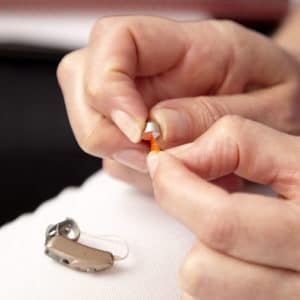Hearing Aid Batteries – the ins and outs
 The battery is a critical but often forgotten part of every hearing aid, providing the power to the device. There are two main ways to power hearing aids – rechargeable and disposable batteries. This article provides you with some information on how to get the best performance from your disposable (zinc – air) hearing aid batteries.
The battery is a critical but often forgotten part of every hearing aid, providing the power to the device. There are two main ways to power hearing aids – rechargeable and disposable batteries. This article provides you with some information on how to get the best performance from your disposable (zinc – air) hearing aid batteries.
For rechargeable hearing aids read this.
The most common type of disposable hearing aid batteries on the market today uses mercury free zinc air technology which means air from the atmosphere is the active ingredient.
Once the tab is removed (as per the image), the battery’s tiny holes become visible; these holes allow air (and the oxygen with air) to enter and power the battery
Air up time
After the tab is removed you should allow the battery sit for a couple of minutes un-tabbed before inserting into your hearing aid. Why? The reason to let it sit is because the air needs time to get into the battery. Immediately removing the tab and inserting the battery into the hearing aid limits its exposure to air. This could cause the battery to seem “dead” because the voltage could not reach the necessary level to power the device.
If this happens, remove the battery, allow air to properly enter the battery and increase the voltage. After a couple of minutes, replace the battery in the device. This actually increases the longevity of the battery. Surprising but true, by taking this step routinely you might find you get an extra day or so out of a battery.
Fresh is best
Like all batteries, zinc air hearing aid batteries will slowly lose charge over time (it is less than 10% per year if you don’t remove tab). The fresher the batteries the better they perform. To determine the expiration date, consult the four-digit date code on the back of the package.
Typically our batteries have 2-3 years of shelf life on them and we rotate and replace stock on a monthly basis so this tends not to be an issue.
Battery voltage
While it states 1.45 volts on the battery package, that figure is peak voltage. In practice if you measure the voltage with a voltmeter right after removing the tab you might see around 1 volt, slowly rising from that over time to around 1.2-1.3v.
It can take up to a day for the peak voltage to be achieved, this is expected and normal and does not affect the performance of the battery and your hearing aid.
Battery life
It is common for people to ask how long their hearing aid battery will last. In a market survey, device users were asked about the battery life of their hearing aids. The ranges of results are presented below, illustrating that life expectancy ranges can vary greatly.
 Size 10: 3 – 10 days
Size 10: 3 – 10 days
Size 312: 3 – 12 days
Size 13: 6 – 14 days
Size 675: 9 – 20 days
There is no one solution that will work for all hearing aid users. The best way to understand the battery life is for an individual to benchmark their battery performance over time.
There are two main variables that affect the battery life of a hearing aid:
- Individual hearing impairment: As severity increases, more amplification is required, resulting in a higher current and a shorter battery life.
- Sound environment: The ambient noise can reduce battery life. A battery will drain more quickly in a restaurant or rock concert than in a library. Also, if the volume is “maxed out” on your hearing aid, the battery will be depleted prematurely.
Which brand is best value or best performing?
We supply 4 different hearing aid battery lines;
In our opinion all 4 lines offer similar performance and differ in price only because of the price we buy them in for. Extra Power is a whitel label version of Rayovac and apart from the packaging is a Rayovac battery offering best value, but there is little difference in price between all four leading brands and ultimately your choice comes down to personal preference.
The majority of the content of this article was kindly supplied by Hearing Lab and Rayovac, here is a link to more detailed information..
